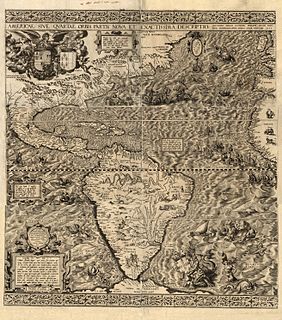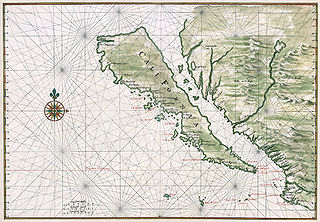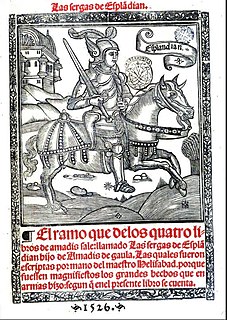 W
WMultiple theories regarding the origin of the name California, as well as the root language of the term, have been proposed, but most historians believe the name likely originated from a 16th century novel, Las Sergas de Esplandián. The novel, popular at the time of the Spanish exploration of Mexico and the Baja California Peninsula, describes a fictional island named California, ruled by Queen Calafia, east of the Indies. The author of the novel, Garci Rodríguez de Montalvo, also known as Ordóñez de Montalvo, is thought to have derived the term California from the Arabic Khalif and/or Khalifa, but he might also have been influenced by the term "Califerne" in the 11th-century epic French poem The Song of Roland.
 W
WMultiple theories regarding the origin of the name California, as well as the root language of the term, have been proposed, but most historians believe the name likely originated from a 16th century novel, Las Sergas de Esplandián. The novel, popular at the time of the Spanish exploration of Mexico and the Baja California Peninsula, describes a fictional island named California, ruled by Queen Calafia, east of the Indies. The author of the novel, Garci Rodríguez de Montalvo, also known as Ordóñez de Montalvo, is thought to have derived the term California from the Arabic Khalif and/or Khalifa, but he might also have been influenced by the term "Califerne" in the 11th-century epic French poem The Song of Roland.
 W
WMultiple theories regarding the origin of the name California, as well as the root language of the term, have been proposed, but most historians believe the name likely originated from a 16th century novel, Las Sergas de Esplandián. The novel, popular at the time of the Spanish exploration of Mexico and the Baja California Peninsula, describes a fictional island named California, ruled by Queen Calafia, east of the Indies. The author of the novel, Garci Rodríguez de Montalvo, also known as Ordóñez de Montalvo, is thought to have derived the term California from the Arabic Khalif and/or Khalifa, but he might also have been influenced by the term "Califerne" in the 11th-century epic French poem The Song of Roland.
 W
WMultiple theories regarding the origin of the name California, as well as the root language of the term, have been proposed, but most historians believe the name likely originated from a 16th century novel, Las Sergas de Esplandián. The novel, popular at the time of the Spanish exploration of Mexico and the Baja California Peninsula, describes a fictional island named California, ruled by Queen Calafia, east of the Indies. The author of the novel, Garci Rodríguez de Montalvo, also known as Ordóñez de Montalvo, is thought to have derived the term California from the Arabic Khalif and/or Khalifa, but he might also have been influenced by the term "Califerne" in the 11th-century epic French poem The Song of Roland.
 W
WMultiple theories regarding the origin of the name California, as well as the root language of the term, have been proposed, but most historians believe the name likely originated from a 16th century novel, Las Sergas de Esplandián. The novel, popular at the time of the Spanish exploration of Mexico and the Baja California Peninsula, describes a fictional island named California, ruled by Queen Calafia, east of the Indies. The author of the novel, Garci Rodríguez de Montalvo, also known as Ordóñez de Montalvo, is thought to have derived the term California from the Arabic Khalif and/or Khalifa, but he might also have been influenced by the term "Califerne" in the 11th-century epic French poem The Song of Roland.
 W
WMultiple theories regarding the origin of the name California, as well as the root language of the term, have been proposed, but most historians believe the name likely originated from a 16th century novel, Las Sergas de Esplandián. The novel, popular at the time of the Spanish exploration of Mexico and the Baja California Peninsula, describes a fictional island named California, ruled by Queen Calafia, east of the Indies. The author of the novel, Garci Rodríguez de Montalvo, also known as Ordóñez de Montalvo, is thought to have derived the term California from the Arabic Khalif and/or Khalifa, but he might also have been influenced by the term "Califerne" in the 11th-century epic French poem The Song of Roland.
 W
WAmadís de Gaula ; Portuguese: Amadis de Gaula, [ɐmɐdjʒ dɨ gawlɐ]) is a landmark work among the chivalric romances which were in vogue in sixteenth-century Iberian Peninsula, although its first version, much revised before printing, was written at the onset of the 14th century.
 W
WIn Greek mythology, the Amazons were a tribe of warrior women believed to live in Asia Minor. Apollonius Rhodius, in his Argonautica, mentions that the Amazons were the daughters of Ares and Harmonia, that they were brutal and aggressive, and their main concern in life was war. Lysias, Isocrates, Philostratus the Elder and Bacchylides also said that their father was Ares.
 W
WAmericae Sive Quartae Orbis Partis Nova Et Exactissima Descriptio is an ornate geographical map of the Americas, made in 1562 by Spanish cartographer Diego Gutiérrez and Flemish artist Hieronymus Cock. The map encompasses the eastern coast of North America, the entire Central and South America and parts of the western coasts of Europe and Africa. Americae Sive Quartae Orbis Partis Nova Et Exactissima Descriptio is the earliest scale wall map of the New World and the first to use the name "California".
 W
WCalafia, or Califia, is the fictional queen of the island of California, first introduced by sixteenth-century poet Garci Rodríguez de Montalvo in his epic, Las sergas de Esplandián, written around 1510. The Californias, a region of North America encompassing the U.S. state of California and the Mexican states of Baja California and Baja California Sur, take their name from Calafia and her kingdom.
 W
WHernán Cortés de Monroy y Pizarro Altamirano, 1st Marquess of the Valley of Oaxaca was a Spanish Conquistador who led an expedition that caused the fall of the Aztec Empire and brought large portions of what is now mainland Mexico under the rule of the King of Castile in the early 16th century. Cortés was part of the generation of Spanish explorers and conquistadors who began the first phase of the Spanish colonization of the Americas.
 W
WGeorge Davidson was a geodesist, astronomer, geographer, surveyor and engineer in the United States.
 W
WThe Gulf of California is a marginal sea of the Pacific Ocean that separates the Baja California Peninsula from the Mexican mainland. It is bordered by the states of Baja California, Baja California Sur, Sonora, and Sinaloa with a coastline of approximately 4,000 km (2,500 mi). Rivers which flow into the Gulf of California include the Colorado, Fuerte, Mayo, Sinaloa, Sonora, and the Yaqui. The surface of the gulf is about 160,000 km2 (62,000 sq mi). Maximum depths exceed 3,000 meters (9,800 ft) because of the complex geology, linked to plate tectonics.
 W
WEdward Everett Hale was an American author, historian, and Unitarian minister, best known for his writings such as "The Man Without a Country", published in Atlantic Monthly, in support of the Union during the Civil War. He was the grand-nephew of Nathan Hale, the American spy during the Revolutionary War.
 W
WThe Island of California refers to a long-held European misconception, dating from the 16th century, that the Baja California Peninsula was not part of mainland North America but rather a large island separated from the continent by a strait now known as the Gulf of California.
 W
WKhalifa or Khalifah is a name or title which means "successor", "ruler" or "leader". It most commonly refers to the leader of a Caliphate, but is also used as a title among various Islamic religious groups and orders. Khalifa is sometimes also pronounced as "kalifa". There were 4 khalifas after Prophet Mohammed died, beginning with Abu Bakr. This was a difficult decision for the people to make, for no one except Prophet Mohammed had ever thought with foresight about who would rule after he would die. The Khilaafat was then contested and gave rise to the eventual division of the Islamic Umma into two groups, the Sunni and the Shi'a who interpret the word, Khalifa in differently nuanced ways.
 W
WGarci Rodríguez de Montalvo was a Castilian author who arranged the modern version of the chivalric romance Amadis of Gaul. Originally written in three books in the 14th century by an unknown author, Montalvo incorporated a fourth book in the original series, and followed it with a sequel, Las sergas de Esplandián. It is the sequel that Montalvo is most often noted for, not for the book itself, but because within the book he coined the word California.
 W
WLas Sergas de Esplandián is a novel written by Garci Rodríguez de Montalvo in the late fifteenth or early sixteenth century. The novel is a sequel to a popular fifteenth century set of chivalric romance novels, Amadís de Gaula. While the novel itself has met with some criticism for its lack of literary style, it achieved particular notability in 1862 when Edward Everett Hale concluded that the novel was the origin of the name California.
 W
WFrancisco de Ulloa was a Spanish explorer who explored the west coast of present-day Mexico under the commission of Hernán Cortés. The reports of his expeditions along the Baja California Peninsula are credited with being influential in the perpetuation of the 17th century cartographic misconception of the existence of the Island of California.